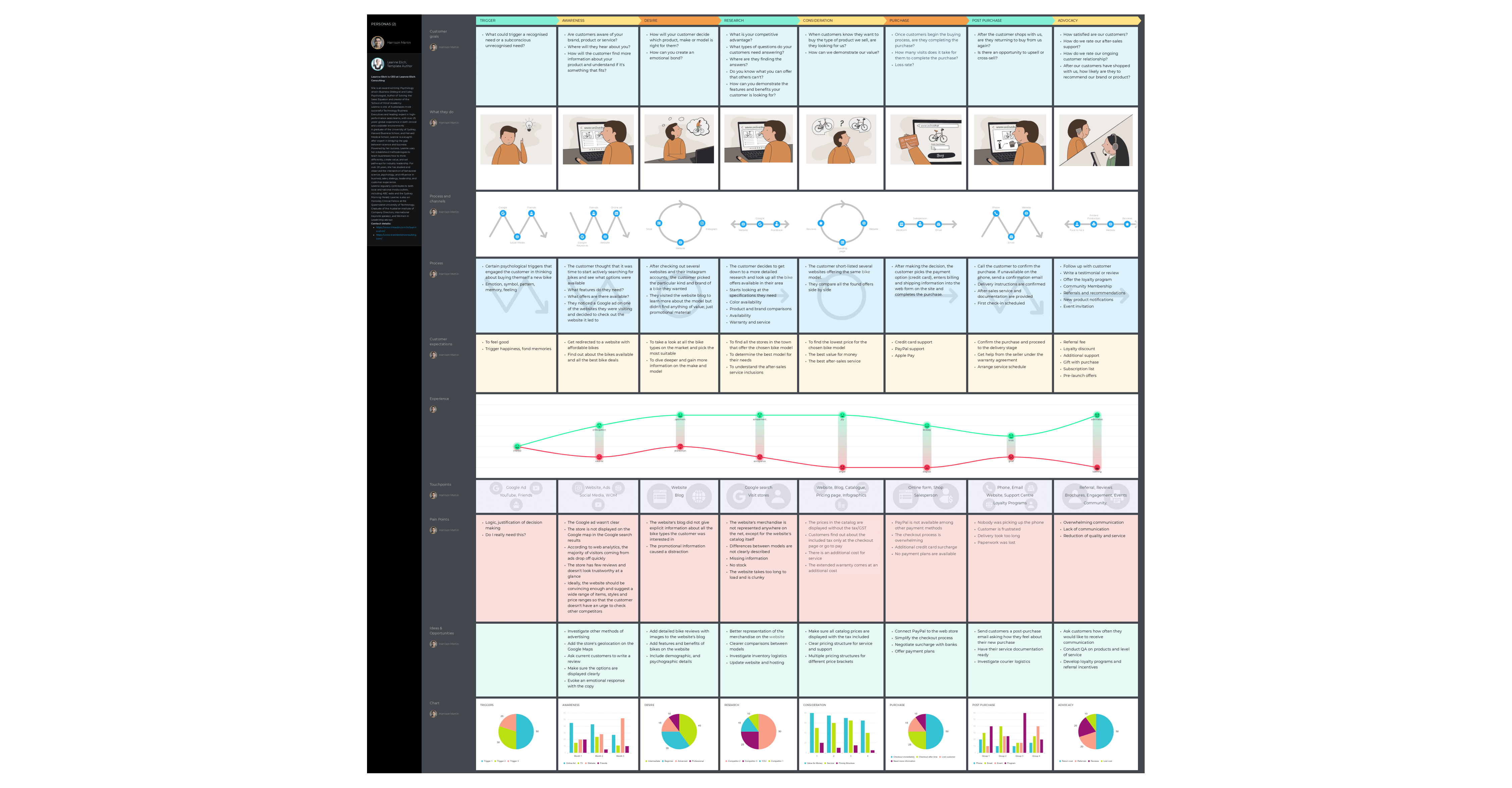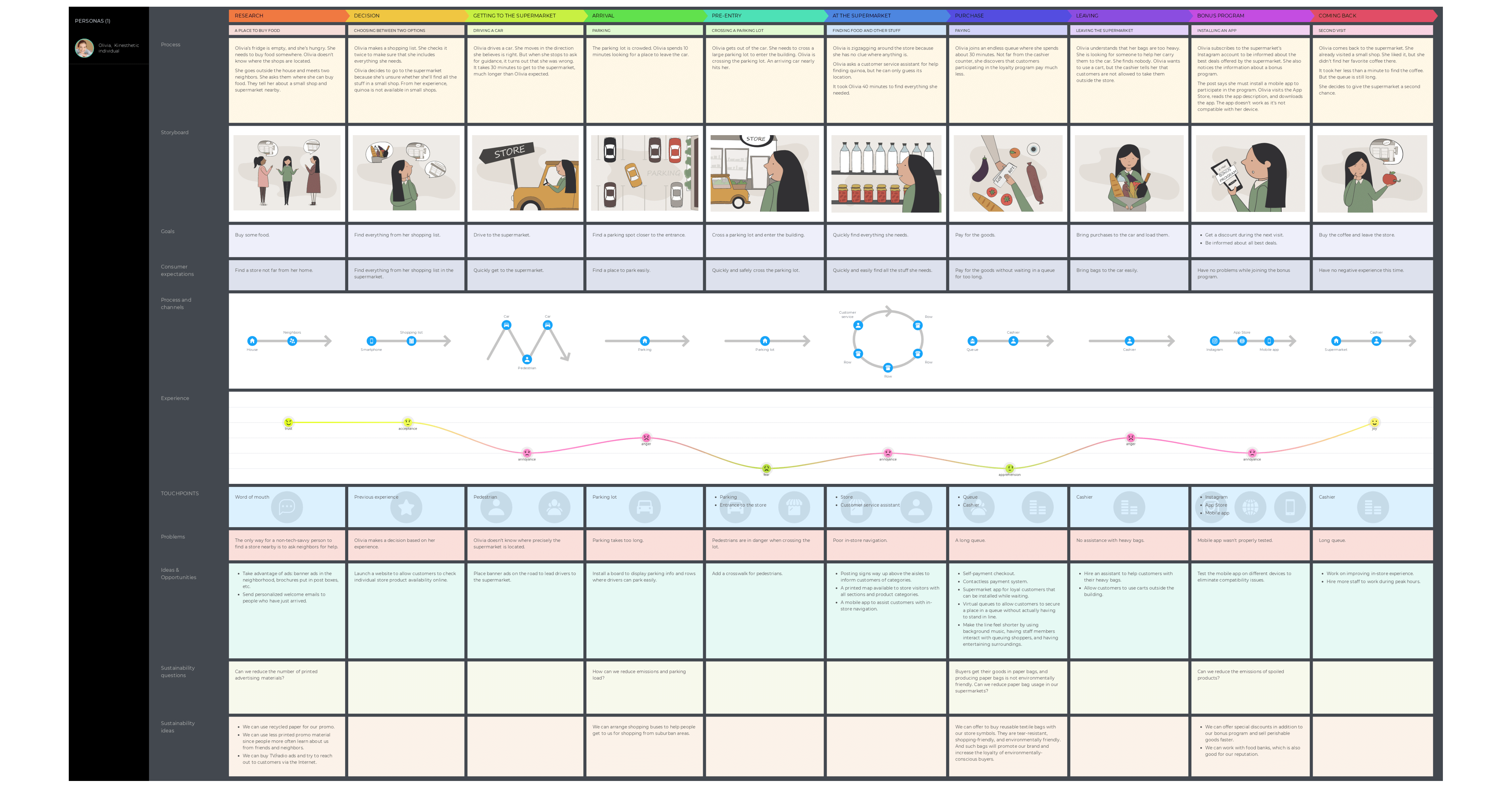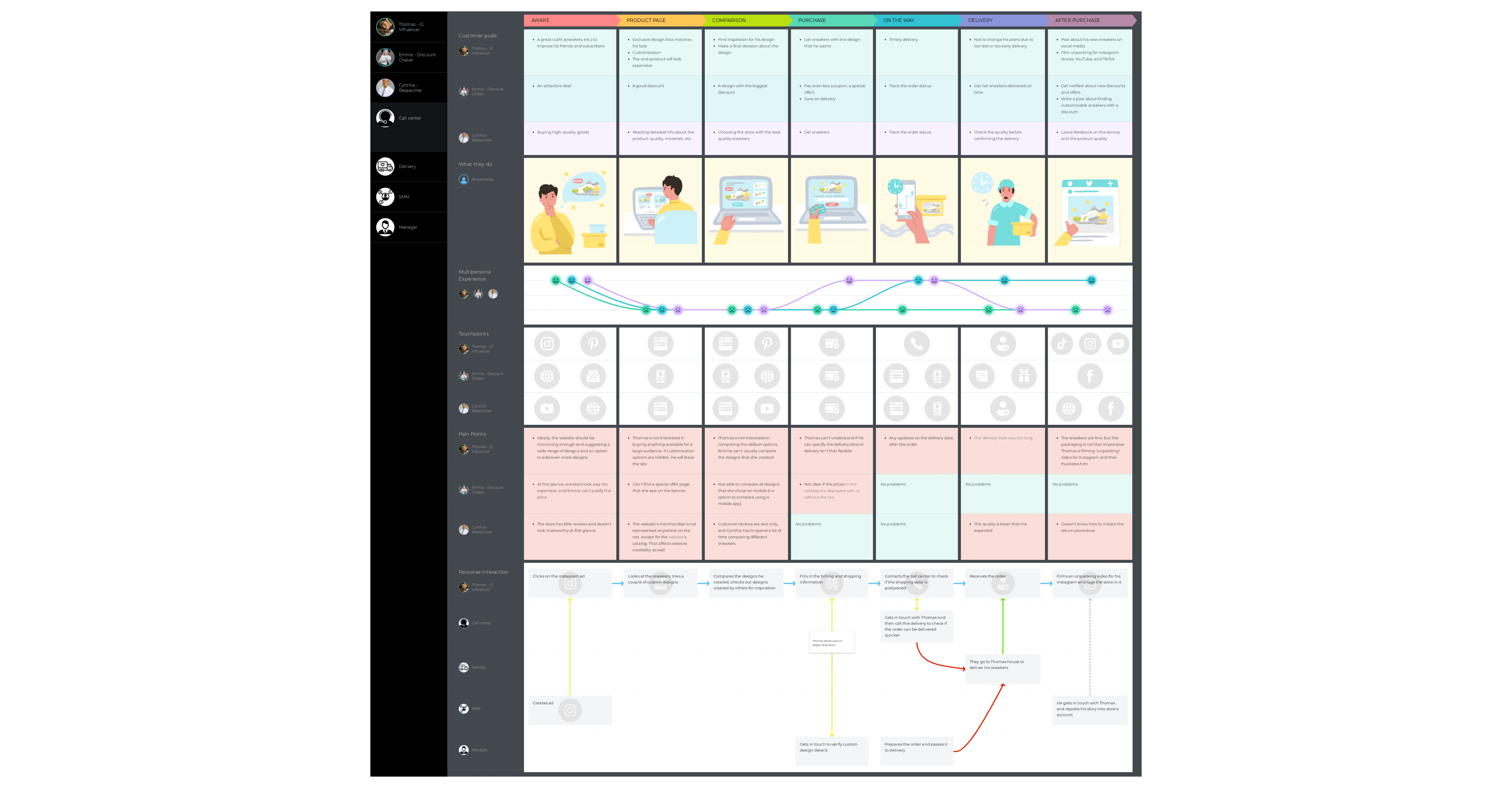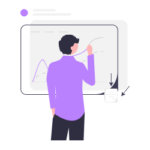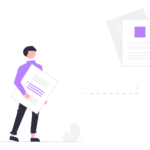Step into the realm where choices weave the intricate fabric of consumer decisions — the buyer journey. As we navigate this landscape, we'll uncover the definition, stages of such a journey, and real-world examples that demystify the process.
Join us on this expedition — no fluff, just the essential roadmap to unravel the buyer journey and decode the patterns that drive purchasing decisions.
Ready to explore the journey that transforms curiosity into commerce? Let's unravel the layers together.
Contents
What is the buyer journey? Why is it important?
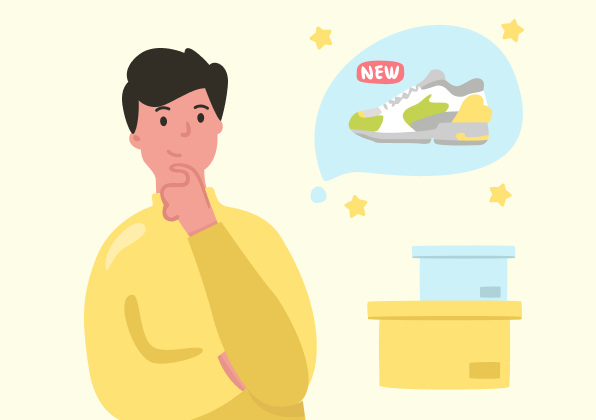
The buyer journey represents the holistic path a buyer takes as they move through the various stages leading to a purchase. It’s a comprehensive process that encapsulates the entirety of a customer's experience, from the initial awareness of a product or service to the final decision-making and post-purchase evaluation. The depth and complexity of such a journey are heightened by the fact that it can be online, offline, or a mix of both. Here are the examples:
- Online journey: A customer discovers a digital product through a targeted social media ad, researches online reviews, and makes a purchase on an e-commerce website. Post-purchase, they use the online product and engage with the brand through email newsletters and online customer support.
- Offline journey: A customer learns about a product through a traditional print advertisement, visits a physical store to explore the item, consults with in-store staff, and makes the purchase. The post-purchase phase involves using the product and potentially providing feedback through physical channels.
- Mixed journey: A customer first encounters a product via an online influencer's review, then visits a brick-and-mortar store to examine it physically. They might purchase online using a mobile app, receiving post-purchase updates through both email and in-store promotions.
Why is the buyer journey important?
Understanding the buyer journey is of paramount importance for businesses for many reasons.
- Customer-centric approach
By comprehending the buyer journey, businesses can adopt a more customer-centric approach. It means aligning products, services, and digital marketing efforts with the needs and preferences of the customers at each journey stage. This customer-centricity fosters a positive and engaging experience, enhancing the likelihood of conversion.
- Tailored marketing strategies
The buyer journey provides businesses with insights into the specific touchpoints and channels that customers engage with during their decision-making process. Armed with this knowledge, organizations can tailor their marketing strategies to be more effective at each stage. For instance, deploy inbound marketing and educational materials to capture attention, especially during the awareness stage.
- Building trust and credibility
Trust is a crucial element in any purchase decision. Understanding a buying journey enables businesses to build trust by delivering consistent messaging, quality content, and positive interactions at each touchpoint. This trust-building process is vital for establishing credibility and driving long-term customer relationships.
- Optimizing user experience
A seamless and enjoyable user experience is critical to guiding potential buyers through the journey. With buyer journey analysis, businesses can identify pain points and areas of improvement in their processes. This could include optimizing website navigation, streamlining checkout processes, or enhancing customer support.

- Data-driven decision-making
The buyer journey map is a valuable source of data that businesses can use to inform their decision-making. Analyzing customer behavior, preferences, and feedback at each stage provides actionable insights. This data-driven approach enables companies to refine their strategies, allocate resources efficiently, and stay agile in a dynamic market.
- Maximizing customer lifetime value
Understanding the buyer journey goes beyond the point of purchase. Post-purchase stages of the journey, such as customer loyalty and advocacy, are crucial for maximizing customer lifetime value. Businesses that continue to engage and delight customers even after the sale are more likely to benefit from repeat business and positive word-of-mouth marketing.
In essence, the buyer journey serves as a roadmap for businesses to navigate the complex landscape of customer decision-making. It empowers companies to meet customer expectations, build lasting relationships, and ultimately drive sustainable business growth.
Buyer journey stages
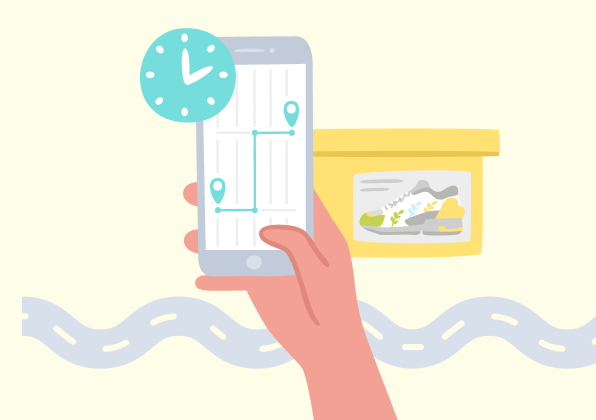
The buyer journey consists of stages a potential customer goes through before making a purchase decision. All journeys are somewhat different, but it's possible to identify broad stages common to each. Let's explore these stages in detail:
- Awareness stage
This is the initial stage where the buyer becomes aware of a problem or need. They may not be aware of specific solutions yet.
Example: Someone realizes they need a new smartphone because their current one is outdated and struggles with performance.
- Research and discovery stage
At this stage, the buyer actively seeks information to understand and define their problem. They research potential solutions and gather relevant data.
Example: The individual might explore various smartphone brands, read reviews, and compare features to find the best fit for their needs.
- Consideration stage
At this point, the buyer narrows down their options and is evaluating specific products or services. They compare features, prices, and benefits.
Example: The person may be deciding between two or three smartphone models based on factors like camera quality, battery life, and overall performance.
- Decision stage
The buyer is now ready to make a decision and commit to a particular product or service. They might look for discounts, compare final prices, and explore additional incentives.
Example: The individual decides to purchase a specific smartphone model, adds it to the cart, and proceeds to check out.
- Purchase stage
This is the point of transaction where the buyer completes the purchase. It could happen online, in-store, or through various other channels.
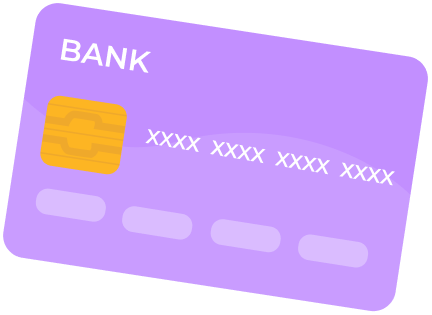
Example: The person confirms the purchase, enters payment information, and receives confirmation of the order.
- Post-purchase stages
After the purchase, the buyer uses the product or service and forms their experience about it. This stage is crucial for customer satisfaction and potential loyalty.
Example: The individual starts using the new smartphone, and their experience is positive. They might leave a review, share their experience on social media, or consider the brand for future purchases.
- Loyalty and advocacy stage
There is an additional stage focusing on turning customers into loyal advocates. This involves fostering ongoing relationships, encouraging repeat business, and leveraging satisfied customers for viral marketing. This stage is often overlooked by businesses, and it's a mistake.
Example: The satisfied smartphone user recommends the brand to friends, engages with loyalty programs, and becomes an advocate for the product.
Read also: How to create a journey map step-by-step + examples
Understanding and visualizing these stages allows businesses to tailor their marketing, sales, and customer support strategies to address customers' specific needs and concerns at each step. It helps create a more personalized and effective approach, ultimately increasing the likelihood of conversion and building long-term customer relationships.
Buyer journey optimization
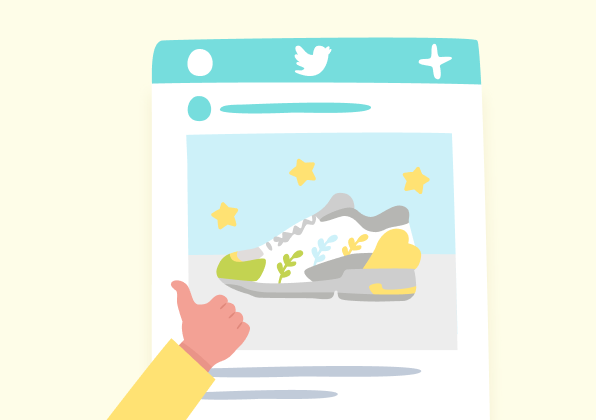
Buyer journey optimization involves refining and enhancing the various stages of the customer's path to purchase to improve overall efficiency, effectiveness, and customer satisfaction and experience.
By strategically optimizing each stage of the journey, businesses can maximize conversion rates, build stronger customer relationships, and increase long-term loyalty. Here's a detailed exploration of buyer journey optimization with examples and potential outcomes:
- Data-driven analysis
Example: A company collects and analyzes data on customer behavior, interactions, and preferences at each stage of the buyer journey using analytics tools and customer relationship management (CRM) systems.
Outcome: Insights gained from data analysis help businesses identify patterns, pain points, and opportunities for improvement in the buyer journey.
- Personalized content and messaging
Example: Leveraging data insights, a business tailors its content and messaging to match the preferences and needs of specific buyer personas at different stages of the journey.
Outcome: Personalized content increases engagement and resonates more effectively with potential customers, leading to a higher likelihood of conversion.
- Seamless multichannel experience
Example: An e-commerce platform ensures a consistent and seamless experience for customers across various channels, including online platforms, mobile apps, and physical stores.
Outcome: A unified multichannel experience reduces friction, enhances customer satisfaction, and provides a cohesive journey regardless of the chosen interaction channel.
- Optimized website and user experience
Example: A company invests in user experience design, making its website intuitive, easy to navigate, and optimized for both desktop and mobile users.
Outcome: Improved website usability enhances customer satisfaction, reduces bounce rates, and encourages visitors to move smoothly through the buyer journey.

- Marketing automation
Example: Implementing digital marketing automation tools to deliver targeted and timely messages, such as personalized emails, based on customer behavior and interactions.
Outcome: Marketing automation streamlines communication, helps to nurture leads, and ensures that potential customers receive relevant information at the right moment in time, increasing the chances of conversion.
- Streamlined checkout process
Example: An e-commerce platform simplifies its checkout process, minimizing the number of steps required and offering various payment options.
Outcome: A streamlined checkout process reduces cart abandonment rates and friction during the purchase stage, leading to higher conversion rates.
- Post-purchase engagement
Example: After a customer makes a purchase, a business engages in post-purchase communication, seeking feedback, offering support, and providing additional resources or exclusive offers.
Outcome: Positive post-purchase engagement contributes to customer satisfaction, encourages repeat business, and fosters brand loyalty.
- Continuous iteration and improvement:
Example: Regularly reviewing analytics, customer feedback, and market trends to identify areas for further optimization and adjustment in the buyer journey strategy.
Outcome: Continuous iteration ensures that the buyer journey remains responsive to changing customer needs and market dynamics, maintaining high levels of effectiveness over time.
In summary, journey optimization is an ongoing process that requires a combination of data analysis, personalization, technological integration, and a customer-centric mindset. By strategically implementing these optimizations, businesses can create a more seamless, engaging, and efficient journey for their customers, ultimately driving higher conversion rates and long-term customer loyalty.
Buyer journey examples
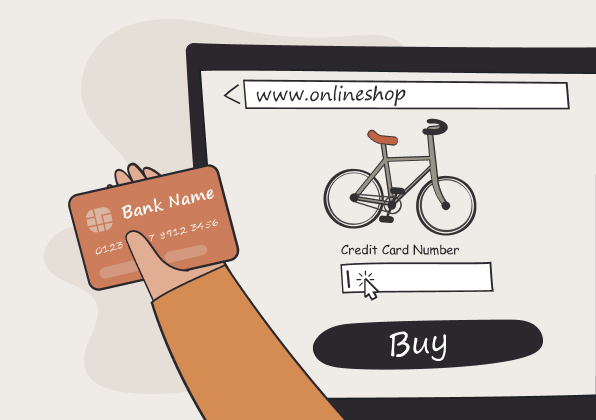
Let's consider a couple of examples of buyer journeys in well-known companies, what they do to improve it, and how it works in practice.
Amazon and its seamless e-commerce experience
Even if you don't use Amazon products, you've definitely heard about them.
- Awareness stage
Amazon excels in creating awareness through targeted ads, personalized recommendations, and a vast product catalog. For example, if a user searches for a specific product, Amazon's algorithms provide relevant suggestions, increasing the chances of discovery.
- Research and discovery stage
The product pages on Amazon are rich in information, featuring detailed product descriptions, customer reviews, and frequently asked questions. This assists customers in making informed decisions during the research stage.
- Consideration stage
Amazon leverages personalized recommendations and targeted emails to remind users about products they viewed or added to their cart. Special promotions, such as lightning deals, create a sense of urgency, influencing the decision-making process.
- Decision stage
The one-click purchase option streamlines the decision-making process, offering a frictionless checkout experience. Amazon's transparent shipping and return policies contribute to the customer's confidence in their decision.
- Post-purchase stage
Amazon invests in post-purchase engagement through order tracking, delivery notifications, and follow-up emails. Additionally, their customer service is readily available to address any issues, enhancing post-purchase satisfaction.
HubSpot and its inbound marketing excellence
HubSpot is a comprehensive inbound marketing, sales, and customer service platform designed to help businesses attract, engage, and delight customers. And they do delight.
- Awareness stage
HubSpot built a robust online presence through inbound marketing. Their blog, webinars, and downloadable resources provide valuable information, attracting businesses looking for marketing and sales solutions.
- Research and discovery stage
HubSpot offers free tools, such as CRM and marketing analytics, allowing users to explore and understand the platform's capabilities before making a commitment. Their educational content assists businesses in the research stage.
- Consideration stage
HubSpot's sales team engages with potential customers through personalized email outreach, offering product demonstrations, and addressing specific pain points. This approach helps businesses evaluate HubSpot's fit for their needs.
- Decision stage
HubSpot's pricing transparency and scalable solutions cater to businesses of different sizes. They provide flexible payment options and a clear onboarding process, making it easier for businesses to decide.
- Post-purchase stage
HubSpot focuses on customer success through continuous education, regular updates on new features, and a vibrant community. They encourage users to maximize the platform's potential, fostering long-term loyalty.
These examples showcase how companies like Amazon and HubSpot strategically engage with customers at each stage of the buyer journey, leading to successful conversions and sustained customer relationships.
Buyer journey templates
Visual aids can often speak louder than words. Therefore, here are some templates for various scenarios. They'll be a great asset to your initiative.
- Case 1: A bicycle buyer journey, where a potential buyer, filled with excitement and a quest for the perfect bicycle, navigates the online realm in search of their two-wheeled companion.
- Case 2: An offline grocery buyer journey, where our persona embarks on the classic journey to the neighborhood supermarket, weaving through aisles in search of sustenance and delights.
- Case 3: A sneakers' buyer journey, where a persona sets out to find the ideal pair of sneakers, exploring the vast world of online options and paving the way for stylish strides.
Wrapping up
In unraveling the complexities of the buyer journey, we've delved into its definition, stages, and real-world examples. This journey is not merely a linear path from awareness to purchase; it's an intricate process that demands a nuanced understanding of customer behavior.
Key takeaways
- Businesses must align products, services, and marketing efforts with customer needs at each stage, fostering positive and engaging experiences.
- Analyzing the buyer journey provides valuable data for refining strategies, optimizing user experiences, and staying agile in a dynamic market.
- Building trust through consistent messaging, quality content, and positive interactions is crucial for establishing credibility and fostering long-term relationships.
- The journey doesn't end with a purchase; positive post-purchase experiences contribute to customer satisfaction, loyalty, and advocacy.
- Buyer journey optimization is an ongoing process involving data analysis, personalization, technological integration, and a customer-centric mindset.
As we navigate the ever-evolving landscape of consumer decisions, understanding and effectively leveraging the buyer journey is not just a strategy; it's a fundamental approach that can drive sustainable business growth. So, let's continue to unravel the layers of this intricate journey, adapting and refining our strategies to meet the ever-changing needs of our customers.
